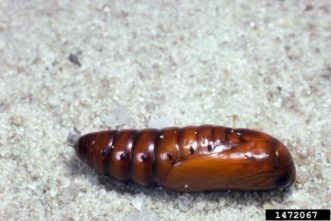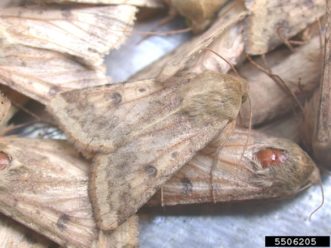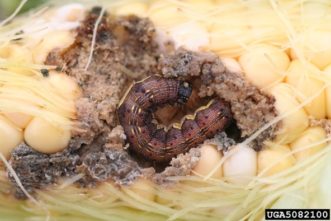Corn earworm, Helicoverpa zea, is the most common aboveground pest of corn in the southeastern United States.1 It is also a significant pest of many other cultivated crops in the Southeast, including cotton, soybean, peanut, sorghum, and numerous vegetable crops. It is known as bollworm in cotton and podworm in soybean. Corn earworm does not overwinter successfully in northern states. However, it reaches the majority of corn-producing areas in the United States each year via migration. The polyphagous (i.e., able to feed on multiple host plants) nature of corn earworm and the reliance on Bt technology for management make this pest important in the southeastern US agroecosystem.
Identification and Life Cycle
Corn earworm successfully overwinters in the soil at latitudes below 40 degrees as a diapaused pupa.2 Full-grown larvae fall to the ground, where they burrow into the ground to pupate, and the pupa are shiny dark red to dark brown (figure 1). Adult corn earworm moths vary in both color and wing markings (figure 3). Single eggs are laid typically on the silks in corn but can be laid on leaf surfaces and the stalk in the absence of silks (figure 2). Larvae develop through an average of six instars, or developmental stages, and vary in color ranging from brown, green, yellow, and pink (figure 4).3 Corn earworm larvae have four pairs of pale prolegs (i.e., fleshy pairs of limbs on abdominal segments) and are covered in hairs/spines, which can help distinguish them from similar species. Fall armyworm (Spodoptera frugiperda) is another species that sometimes be found feeding on corn ears and can be distinguished from corn earworm by an inverted “Y” on its head and an absence of hairs/spines. When larvae first hatch, they begin feeding on the egg and move into the ear through the silks. Typically only a single larva will feed on an individual corn ear due to cannibalism.
Injury to Corn
Corn earworm can feed on foliage throughout the season. However, this type of feeding is uncommon and does not cause economic injury.3 The most common injury comes in the form of direct feeding on developing corn kernels. When eggs are laid on the silks, larvae hatch and begin feeding down the silk channel into the ear. Feeding is usually limited just to the tip of the ear where kernels do not complete development. Complete larval development can occur with larvae only feeding on the tip. While kernel feeding does occur, corn earworm is generally not considered to be an economic pest when corn is planted at the proper time.4 In addition to direct feeding, corn earworm injury may provide entry for fungal pathogens leading to an increase in the levels of aflatoxins and fumonisins, which pose a threat to human and animal health.5
Management
Cultural Control
Planting date plays a major role in managing population size during critical stages of corn development. Earlier planting within recommended planting windows can help avoid major corn earworm pressure later in the season.6 Contact your local extension agent to discuss the planting window for your area. Corn is a preferred host during reproductive growth stages when silks are present, at which time additional cultural practices to limit population size are not currently known.
Biological Control
Several species of parasitoids can attack the eggs of corn earworms prior to hatching. These parasitoids occur naturally in the field, and there is evidence from research trials that inundative (i.e., releasing a large number of parasitoids from an outside source) releases of parasitoids can provide additional control in an IPM program.7 Although inundative releases of parasitoids shows potential, it is currently not feasible in a commercial setting. Once feeding in the ear begins, larvae are fairly protected from natural enemies in corn. In addition to natural biological control agents, nucleopolyhedroviruses (NPV) are a form of highly specific biopesticides which can infect corn earworms and reduce populations.8 While the biological control strategies mentioned here can potentially provide some control, research is required on the economic benefits when applied to control corn earworm.
Chemical Control
The use of chemical control is difficult because larvae feeding in the ear are protected from contact with the insecticide. Even when intensive insecticide trials have been conducted with efficacious insecticides, injury still occurred in non-Bt corn due to difficulty in proper timing of applications.4 For insecticide applications to be effective, they need to be targeted at recently emerged larvae before they feed down the silks into the ear. Given the generally minor pest status of corn earworm in field corn and the challenges related to chemical control, insecticides are not recommended for this insect in field corn. As a note, this comment does not refer to sweet corn where tolerance to earworm feeding is much lower, and insecticides are often used more intensively.
Bt Corn
Modern management of corn earworm primarily relies on using transgenic Bt corn hybrids. Bt corn hybrids are genetically modified to include part of a gene from the soil-based bacterium Bacillus thuringiensis (Bt), which allows the corn to produce toxins that target a specific range of pests. Bt corn was first introduced in 1995 to manage the European corn borer, a stalk boring insect that was a significant pest at the time.9 Initially, these Bt traits included a single toxin (Cry1Ab), but more recent traits include two or more toxins (table 1). In addition to controlling or suppressing corn earworm, these traits also provide control or suppression for a number of other pests, including fall armyworm (Spodoptera frugiperda), lesser cornstalk borer (Elasmopalpus lignosellus), sugarcane borer (Diatraea saccharalis), western bean cutworm (Striacosta albicosta), black cutworms (Agrotis ipsilon). The efficacy of modern commercial Bt toxins for corn earworm control in field corn are provided in table 1. There are other Bt traits available for below-ground pests (rootworms) not listed in this table.
Table 1. Bt corn product efficacy for corn earworm.
| Trade name | Bt toxins | Efficacy for CEW |
| Agrisure Artesian 3010A | Cry1Ab | P-F |
| Agrisure GT/CB/LL | Cry1Ab | P-F |
| Agrisure 3000 GT, Agrisure Artesian 3011A | Cry1Ab, mCry3A3 | P-F |
| Agrisure Viptera 3110 | Vip3Aa20, Cry1Ab | E |
| Agrisure Viptera 3111 | Vip3Aa20, Cry1Ab, mCry3A3 | E |
| Agrisure Viptera 3220 | Vip3Aa20, Cry1Ab, Cry1F | E |
| Herculex I | Cry1F | P |
| Optimum Intrasect | Cry1F, Cry1Ab | F |
| Optimum Intrasect XTRA | Cry1F, Cry1Ab, Cry34Ab1/Cry35Ab13 | F |
| Optimum Leptra | Cry1F, Cry1Ab, Vip3Aa20 | E |
| YieldGard Corn | Cry1Ab | P-F |
| YieldGard VT Triple | Cry1Ab, Cry3Bb13 | P-F |
| Genuity VT Double PRO | Cry1A.105, Cry2Ab2 | P-F |
| Genuity VT Triple PRO | Cry1A.105, Cry2Ab2, Cry3Bb13 | P-F |
| Powercore | Cry1A.105, Cry2Ab2, Cry1F | F |
| Smartstax or Genuity SmartStax | Cry1A.105, Cry2Ab2, Cry1F, Cry3Bb13, Cry34Ab1/Cry35Ab13 | F |
| Trecepta | Cry1A.105, Cry2Ab2, Vip3Aa20 | E |
Resistance Management
The development of resistance to several Bt toxins has been documented in corn earworm populations in the southeastern United States.10–13 Only Bt corn hybrids that include the toxin Vip3Aa20 currently provide excellent levels of control. For all other Bt toxins and their combinations, growers should expect greater variability in levels of suppression of corn earworm kernel injury. Although corn earworm is not an economic pest of field corn in most cases, many of the same Bt toxins are used in cotton, where bollworm is a major pest. This often exposes corn earworms to the same toxins multiple times across generations within the same year, increasing the potential for resistance development. Development of resistance has led to increased injury levels in Bt cotton, in addition to more frequent applications of insecticide.14
To delay the development of Bt resistance, growers are required to plant a non-Bt corn refuge.15 This strategy involves planting non-Bt corn within a Bt cornfield or within half a mile of the Bt corn field to promote the survival of Bt susceptible individuals, which will subsequently mate and dilute potential resistance. The amount of non-Bt refuge required varies according to the number of toxins expressed in Bt corn and if corn is planted in cotton-growing counties. In cotton growing counties, refuge requirements are 50% for single toxin Bt corn and 20% for multiple toxin Bt corn. Non-Bt refuge can be planted in blocks, in a separate location within half a mile of the Bt field, or in 4-row strips in the Bt field. For more information on managing Bt resistance development, read the Insecticide Resistance: Overview and Management publication in Land-Grant Press by Clemson Extension (lgpress.clemson.edu/publication/insecticide-resistance-overview-and-management/).
Summary
While corn earworm generally does not cause economic injury even when using non-Bt corn hybrids, it is a highly polyphagous pest, and its management in corn is an important consideration for the entire Southeastern farmscape. Implementing an integrated management strategy that uses a combination of available cultural control strategies, promoting populations of biological control agents by using compatible insecticides farmscape-wide, and transgenic corn hybrids can ultimately reduce population levels in corn. The most important consideration is Bt resistance management through structured refuge, which can delay the development of resistance and preserve the effectiveness of crucial Bt technologies for the future.
References Cited
- Cartwright O. A survey of field infestations of insects attacking corn in the ear in South Carolina. Journal of Economic Entomology. 1939;32(6):780–782.
- Hardwick D. The corn earworm complex. The Memoirs of the Entomological Society of Canada. 1965;97(S40):5–247.
- Quaintance A, Brues C. The cotton bollworm. Bulletin N. Washington (DC): US Department of Agriculture, Bureau of Entomology; 1905.
- Reay-Jones FPF, Reisig DD. Impact of corn earworm injury on yield of transgenic corn producing bt toxins in the carolinas. Journal of Economic Entomology. 2014;107(3):1101–1109. doi:10.1603/EC13516.
- Munkvold G. Epidemiology of Fusarium diseases and their mycotoxins in maize ears. European Journal of Plant Pathology. 2003;109:705–713.
- Buntin GD, All JN, Lee RD, Wilson DM. Plant-incorporated Bacillus thuringiensis resistance for control of fall armyworm and corn earworm (Lepidoptera: Noctuidae) in corn. Journal of Economic Entomology. 2004;97(5):1603–1611. doi:10.1603/0022-0493-97.5.1603.
- Proshold F, Gross H, Carpenter J. Inundative release of Archytas marmoratus (Diptera: Tachinidae) against the corn earworm and fall armyworm (Lepidoptera: Noctuidae) in whorl-stage corn. Journal of Entomological Science. 1998;33(3):241–255. doi:https://doi.org/10.18474/0749-8004-33.3.241.
- Pingel RL, Lewis LC. Effect of Bacillus thuringiensis, Anagrapha falcifera multiple nucleopolyhedrovirus, and their mixture on three lepidopteran corn ear pests. Journal of Economic Entomology. 1999;92(1):91–96. doi:10.1093/jee/92.1.91.
- Koziel MG, Beland GL, Bowman C, Carozzi NB, Crenshaw R, Crossland L, Dawson J, Desai N, Hill M, Kadwell S, et al. Field performance of elite transgenic maize plants expressing an insecticidal protein derived from Bacillus thuringiensis. Bio/Technology. 1993;11(2):194–200. doi:10.1038/nbt0293-194.
- Reisig DD, Reay-Jones FPF. Inhibition of Helicoverpa zea (Lepidoptera: Noctuidae) growth by transgenic corn expressing bt toxins and development of resistance to Cry1Ab. Environmental Entomology. 2015;44(4):1275–1285. doi:10.1093/ee/nvv076.
- Dively GP, Venugopal PD, Finkenbinder C. Field-evolved resistance in corn earworm to cry proteins expressed by transgenic sweet corn. PLoS ONE. 2016;11(12):1–22. doi:10.1371/journal.pone.0169115.
- Bilbo TR, Reay-Jones FPF, Reisig DD, Greene JK. Susceptibility of corn earworm (Lepidoptera: Noctuidae) to Cry1A.105 and Cry2Ab2 in North and South Carolina. Journal of Economic Entomology. 2019;112(4):1845–1857. doi:10.1093/jee/toz062.
- Ali MI, Luttrell RG, Young SY. Susceptibilities of Helicoverpa zea and Heliothis virescens (Lepidoptera: Noctuidae) populations to Cry1Ac insecticidal protein. Journal of Economic Entomology. 2006;99(1):164–175. doi:10.1603/0022-0493(2006)099[0164:SOHZAH]2.0.CO;2.
- Reisig DD, Huseth AS, Bacheler JS, Aghaee MR, Braswell L, Burrack HJ, Flanders K, Greene JK, Herbert DA, Jacobson A, Paula-Moraes SV, Roberts P, Taylor SV. Long-term empirical and observational evidence of practical Helicoverpa zea resistance to cotton with pyramided toxins. Journal of Economic Entomology. 2018;111(4): 1824-1833. doi:10.1093/jee/toy106.
- Gould F. Sustainability of transgenic insecticidal cultivars: integrating pest genetics and ecology. Annual Review of Entomology. 1998;43(1):701–726. doi:10.1146/annurev.ento.43.1.701.





